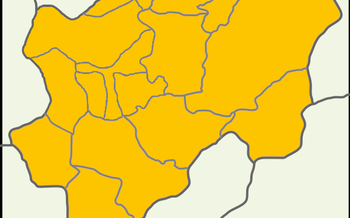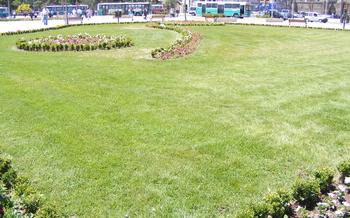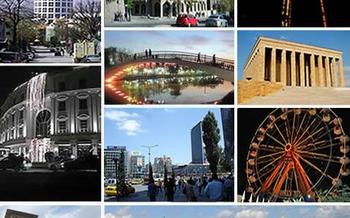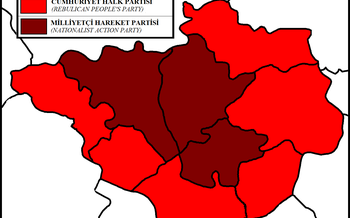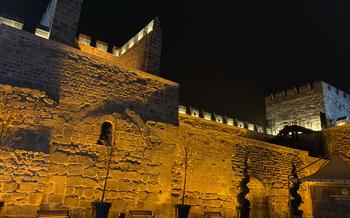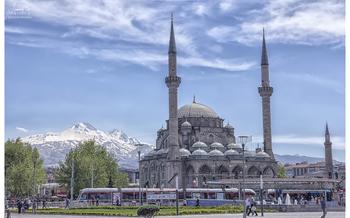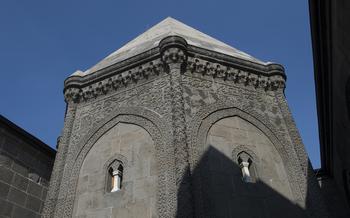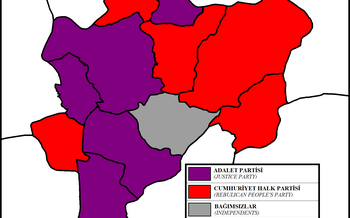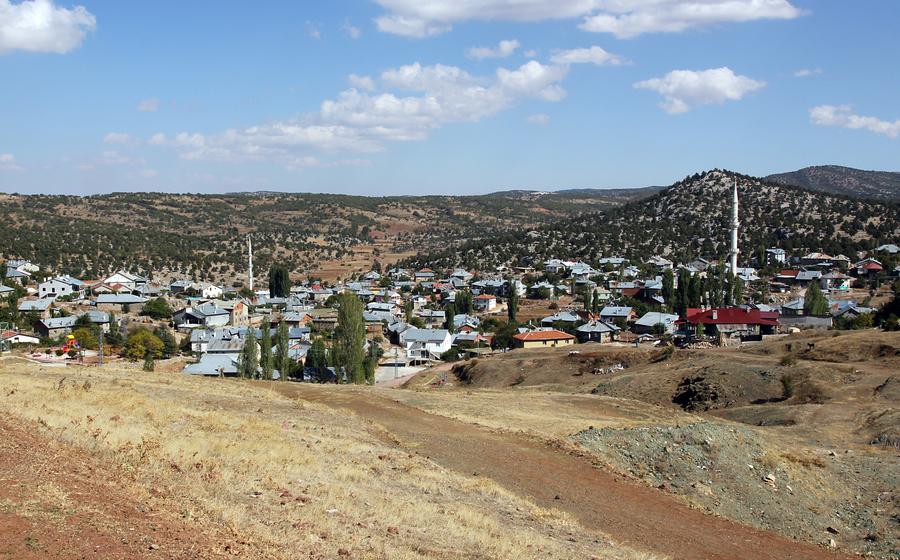
Hacılar
- Temple of King Tudhaliya IV: A Royal Legacy
- Sphinx Gate and Fortifications: Guardians of Hacılar
- Lion Relief: A Symbol of Strength
- Hittite Hieroglyphics: Ancient Script Unveiled
- Kings' Processional Road: A Path of Power
- Granaries and Storage Facilities: Ancient Supply Systems
- Kayseri Castle: A Majestic Citadel
- Mount Erciyes: Nature's Playground
- Kayseri Cuisine: A Culinary Journey
- Shopping in Kayseri: Treasures and Handicrafts
- Traditional Crafts
- Local Markets
- Bargaining Tips
- Shopping Districts
- Cultural Festivals and Events: Celebrating Traditions
- Getting to Kayseri: Transportation Options
- Insider Tip: Unveiling Hidden Gems
Temple of King Tudhaliya IV: A Royal Legacy
Amidst the ruins of Hacılar, the Temple of King Tudhaliya IV stands as a testament to the grandeur of the ancient Hittite civilization. Dedicated to the Hittite king Tudhaliya IV, this well-preserved temple offers a glimpse into the religious beliefs and practices of the Hittites.
Marvel at the intricate rock reliefs adorning the temple's walls, depicting King Tudhaliya IV and his entourage in ceremonial processions. These reliefs provide insights into the king's authority and the importance of religious rituals in Hittite society.
Explore the temple's layout, consisting of a series of chambers and courtyards. Each chamber served a specific purpose, from housing religious artifacts to conducting ceremonies. The temple's architecture reflects the Hittites' advanced understanding of construction techniques and their attention to detail.
Stand in awe of the temple's imposing presence, surrounded by the remnants of the ancient city. Imagine the grandeur of religious ceremonies conducted within these walls, as the Hittites sought divine favor and celebrated their cultural heritage.
Visiting the Temple of King Tudhaliya IV is a journey through time, offering a tangible connection to the Hittite civilization. Let the temple's grandeur transport you to a world of ancient rituals, royal authority, and architectural marvels.
Sphinx Gate and Fortifications: Guardians of Hacılar
The Sphinx Gate stands as a testament to the architectural prowess and defensive capabilities of the ancient Hittites. Flanked by two colossal sphinxes carved from a single block of stone, the gate exudes an aura of majesty and power. These sphinxes, with their human heads and lion bodies, symbolize strength, protection, and the divine nature of the Hittite kings.
Beyond the Sphinx Gate lies a network of massive fortifications, showcasing the Hittites' mastery of military engineering. The city walls, constructed from large stone blocks, rise high above the surrounding landscape, providing an impenetrable barrier against invaders. The walls are further reinforced by numerous towers and gateways, each strategically positioned to maximize defense and surveillance.
These defensive structures not only protected the city from external threats but also served as symbols of Hittite power and authority. The sheer size and strength of the fortifications conveyed a clear message to potential enemies: Hacılar was an impregnable fortress, well-defended and capable of withstanding any attack.
Exploring the Sphinx Gate and the fortifications allows visitors to gain a deep appreciation for the Hittites' architectural ingenuity and their strategic prowess. These structures stand as enduring reminders of a civilization that valued both military strength and artistic excellence.
Lion Relief: A Symbol of Strength
Amidst the ruins of Hacılar, one of the most striking sights is the lion relief, carved majestically into a rock face. This awe-inspiring artwork depicts a powerful lion, its regal presence exuding strength and authority. The lion, a symbol deeply revered in Hittite culture, represents the fierce protection and power of the Hittite kings.
The lion relief is not merely a decorative element; it holds profound symbolic meaning. In Hittite mythology, the lion was associated with the sun god, who was believed to be the protector of the Hittite kingdom. The lion's imposing figure served as a reminder of the sun god's protective power and the strength of the Hittite monarchy.
To fully appreciate the significance of the lion relief, it's essential to understand its cultural context. In Hittite iconography, lions were often depicted in various forms, from majestic sculptures to fierce reliefs. These representations symbolized the Hittites' admiration for the lion's strength, courage, and protective nature.
Finding the lion relief is relatively straightforward. It is situated within the archaeological site of Hacılar, near the ruins of the temple dedicated to King Tudhaliya IV. As you explore the site, keep an eye out for this remarkable artwork, a testament to the artistic prowess and cultural significance of the ancient Hittites.
Hittite Hieroglyphics: Ancient Script Unveiled
Unveiling the mysteries of the past, the Hittite hieroglyphics at Hacılar offer a tantalizing glimpse into the written language of the ancient Hittites. Deciphered with the help of bilingual inscriptions, these hieroglyphs provide valuable insights into the history, culture, and beliefs of this fascinating civilization. Explore the site and discover where these enigmatic inscriptions are located, revealing the stories they hold from a bygone era.
Kings' Processional Road: A Path of Power
The Kings' Processional Road is an evocative vestige of Hacılar's past, beckoning visitors to walk in the footsteps of ancient Hittite royalty. This ceremonial route once served as a stage for grand processions, where Hittite kings and their retinues paraded in all their glory. As you tread upon this ancient path, imagine the grandeur of these processions, the rhythmic cadence of footsteps, and the vibrant colors of ceremonial attire.
The road's religious significance is palpable, as it connected the city's main temple with other sacred sites. Processions along this route were not merely displays of power but also acts of devotion, paying homage to the Hittite gods and seeking their favor.
The Kings' Processional Road is a testament to Hittite engineering prowess, showcasing their mastery of urban planning and architecture. Its unique features, such as carefully laid stone blocks and intricate drainage systems, reveal the sophistication of their construction techniques.
Follow the route, allowing your imagination to transport you back in time. Picture the Hittite king, resplendent in his royal regalia, leading a procession of nobles, priests, and soldiers, all adorned in their finest attire. The air would have been filled with the sound of music, the chanting of hymns, and the cheers of the gathered populace.
Walk along this ancient path, and let the echoes of history guide you, providing a glimpse into the grandeur and devotion of the Hittite civilization.
Granaries and Storage Facilities: Ancient Supply Systems
Amidst the ruins of Hacılar, the well-preserved granaries and storage facilities offer a glimpse into the logistical prowess of the Hittites. These structures, designed with remarkable architectural precision, served as repositories for grain and other essential supplies, ensuring the stability and sustenance of the ancient city.
The granaries, with their sturdy walls and carefully engineered ventilation systems, showcase the Hittites' mastery of food storage techniques. The sheer size and number of these facilities underscore the importance of maintaining strategic reserves in an era where agriculture was the lifeblood of civilizations.
Exploring the excavated granaries, visitors can marvel at the intricate construction methods employed by the Hittites. The use of stone and mud bricks, combined with innovative architectural features, ensured the preservation of grain and other commodities for extended periods.
These storage facilities not only highlight the Hittites' practical ingenuity but also provide valuable insights into their economic organization. The efficient management of resources was crucial for sustaining a thriving urban center like Hacılar, and the granaries played a pivotal role in this regard.
By examining these ancient storehouses, visitors gain a deeper appreciation for the logistical challenges faced by ancient civilizations and the remarkable solutions they devised to ensure their survival and prosperity.
Kayseri Castle: A Majestic Citadel
In the heart of Kayseri stands the imposing Kayseri Castle, a testament to the architectural prowess of the Seljuk Turks who ruled the region in the 13th century. This magnificent fortress, perched atop a hill, commands attention with its towering walls, majestic towers, and intricate gateways.
As you approach the castle, its grandeur unfolds before you. The sturdy stone ramparts, punctuated by arrow slits and crenellations, hint at the defensive capabilities of this formidable stronghold. The main entrance, adorned with intricate carvings and inscriptions, invites you into a world of history and intrigue.
Inside the castle, a labyrinth of narrow cobblestone streets leads you through time. Explore the various chambers, once used as barracks, storerooms, and administrative offices. Marvel at the architectural details, such as vaulted ceilings, arched doorways, and decorative niches.
Ascend the winding staircases to the castle's ramparts, where breathtaking panoramic views await. From this vantage point, you can feast your eyes on the sprawling city of Kayseri, the verdant plains beyond, and the distant snow-capped peaks of Mount Erciyes.
Kayseri Castle is not merely a historical relic but also a vibrant cultural hub. Throughout the year, it hosts various events, exhibitions, and festivals that showcase the rich heritage of the region. Immerse yourself in traditional music performances, dance shows, and culinary delights as you experience the vibrant tapestry of Kayseri's culture.
Practical Information:
- Visiting Hours: The castle is open to visitors daily from 9 am to 5 pm.
- Admission Fees: A nominal entrance fee is required to enter the castle.
- Guided Tours: Guided tours are available in multiple languages, providing insights into the castle's history, architecture, and significance.
Mount Erciyes: Nature's Playground
Towering over the city of Kayseri, Mount Erciyes is an extinct volcano that beckons nature enthusiasts with its stunning scenery and diverse outdoor activities. Ascend the majestic peak and discover a world of natural wonders.
Embark on invigorating hikes through lush forests, marveling at the unique flora and fauna that thrive in the mountain ecosystem. Challenge yourself with a thrilling mountain climb, reaching the summit to witness breathtaking panoramic views. For a more leisurely experience, glide down the snowy slopes on skis or a snowboard, enjoying the exhilaration of winter sports amidst breathtaking landscapes.
Mount Erciyes offers a playground for every nature lover. Whether you seek adventure, tranquility, or simply the chance to reconnect with the wilderness, this majestic peak has something to offer. Plan your visit carefully, considering the best time of year for your chosen activities, and don't forget essential gear and safety precautions to ensure a memorable and safe journey.
Kayseri Cuisine: A Culinary Journey
Indulge in the tantalizing flavors of Kayseri, a culinary paradise that boasts a rich and diverse cuisine. Embark on a gastronomic adventure and savor the delectable mantı, Turkish ravioli filled with minced meat and topped with a tangy yogurt sauce. Don't miss the pastırma, a unique cured beef that's air-dried and seasoned to perfection, offering a burst of savory flavors. For a sweet indulgence, treat yourself to sütlaç, a creamy rice pudding sprinkled with cinnamon, a testament to Kayseri's mastery of desserts.
Explore the vibrant culinary heritage of the region, influenced by various cultures that have left their mark on Kayseri's cuisine. Discover the must-try dishes that showcase the unique flavors of this culinary melting pot. Join a food tour to sample the local delicacies and learn about their history and significance. Immerse yourself in the culinary traditions of Kayseri and let your taste buds dance with delight.
Shopping in Kayseri: Treasures and Handicrafts
Kayseri is a treasure trove for those seeking unique souvenirs and handmade crafts. The city's rich history and cultural heritage are reflected in its vibrant handicraft traditions, which have been passed down through generations.
Traditional Crafts
One of the most famous crafts of Kayseri is carpet weaving. Kayseri carpets are renowned for their intricate designs, vibrant colors, and high quality. Visitors can find a wide variety of carpets, from traditional patterns to modern designs, in the city's many carpet shops.
Another popular craft is pottery. Kayseri potters create a variety of ceramic items, including plates, bowls, vases, and tiles. These items are often decorated with colorful glazes and intricate patterns, making them both functional and decorative.
Metalworking is another important craft in Kayseri. Local artisans create a variety of metal objects, such as jewelry, cutlery, and decorative items. Kayseri is particularly known for its silver jewelry, which is often adorned with semi-precious stones and intricate designs.
Local Markets
The best place to find handmade crafts in Kayseri is in the city's many markets and bazaars. The Grand Bazaar, located in the heart of the city, is a must-visit for shoppers. This bustling market is home to hundreds of stalls selling a wide variety of goods, including carpets, pottery, jewelry, and clothing.
Another popular market is the Arasta Bazaar, which is located near the Kayseri Castle. This market specializes in antiques and handicrafts, and visitors can find a variety of unique items, such as old coins, vintage jewelry, and traditional Turkish musical instruments.
Bargaining Tips
When shopping in Kayseri, it is important to be prepared to bargain. Bargaining is a common practice in Turkey, and it is a great way to get a good deal on your purchases. When bargaining, be polite and respectful, and be prepared to walk away if you are not satisfied with the price.
Shopping Districts
The best areas for shopping in Kayseri are the city center and the Talas district. The city center is home to a variety of shops, boutiques, and markets, while the Talas district is known for its traditional crafts and handicrafts.
Whether you are looking for a unique souvenir or a special gift, you are sure to find something to your liking in Kayseri. The city's vibrant handicraft traditions and bustling markets offer a treasure trove of shopping opportunities for visitors from all over the world.
Cultural Festivals and Events: Celebrating Traditions
Kayseri comes alive during its vibrant cultural festivals and events, offering a kaleidoscope of colors, music, and traditions. Immerse yourself in the city's rich heritage as you witness traditional music and dance performances, colorful processions, and lively celebrations that showcase the local way of life. These festivals provide an exceptional opportunity to connect with the local community, gain insights into their customs and beliefs, and experience the infectious energy that fills the streets. Discover the annual festival calendar to plan your visit around these cultural extravaganzas and make your Kayseri trip a truly memorable one.
Getting to Kayseri: Transportation Options
Kayseri, a vibrant city nestled in the heart of Turkey, offers a range of transportation options for travelers seeking to explore its rich history, natural wonders, and cultural heritage.
Air Travel:
- Kayseri Airport (ASR) is the main gateway to the city, with direct flights connecting to major cities in Turkey and beyond.
- Several airlines, including Turkish Airlines, Pegasus Airlines, and AnadoluJet, operate regular flights to Kayseri from Istanbul, Ankara, and other domestic and international destinations.
- Flight duration from Istanbul to Kayseri is approximately 1 hour and 15 minutes.
Land Transportation:
- Kayseri is well-connected by bus and train services to major cities in Turkey, providing a convenient and affordable option for travelers.
- Buses depart from major bus terminals in Istanbul, Ankara, and other cities, offering a comfortable and scenic journey.
- Train services are available from Istanbul and Ankara, with a travel time of approximately 10 hours.
Road Trip:
- For those seeking a more adventurous experience, a road trip to Kayseri offers a chance to explore the stunning landscapes of Turkey.
- The city is accessible via well-maintained highways from Istanbul, Ankara, and other regions.
- Consider planning a stopover in Cappadocia, a UNESCO World Heritage Site renowned for its unique rock formations and hot air balloon rides.
Local Transportation:
- Once in Kayseri, getting around the city is easy with a variety of transportation options available.
- Public buses, taxis, and rental cars are readily accessible, allowing visitors to explore the city's attractions conveniently.
- The city's compact size makes it easy to navigate on foot, offering the opportunity to soak in the local atmosphere and discover hidden gems.
Insider Tip: Unveiling Hidden Gems
Beyond the popular attractions, Kayseri offers a treasure trove of hidden gems waiting to be discovered.
-
Explore the rarely visited Byzantine churches and monasteries scattered throughout the province, offering a glimpse into the region's rich religious history.
-
Venture off the beaten path to discover natural wonders like Kapuzbaşı Waterfalls, cascading down a sheer rock face amidst lush greenery.
-
Immerse yourself in the vibrant local culture by attending traditional wrestling matches, a unique sport deeply rooted in Turkish heritage.
-
For a unique culinary experience, seek out family-run restaurants in the countryside, where you can savor authentic home-cooked dishes prepared with fresh, local ingredients.
-
If visiting during the winter months, don't miss the opportunity to experience the Kayseri Snow Festival, showcasing snow sculptures, winter sports, and cultural performances.
